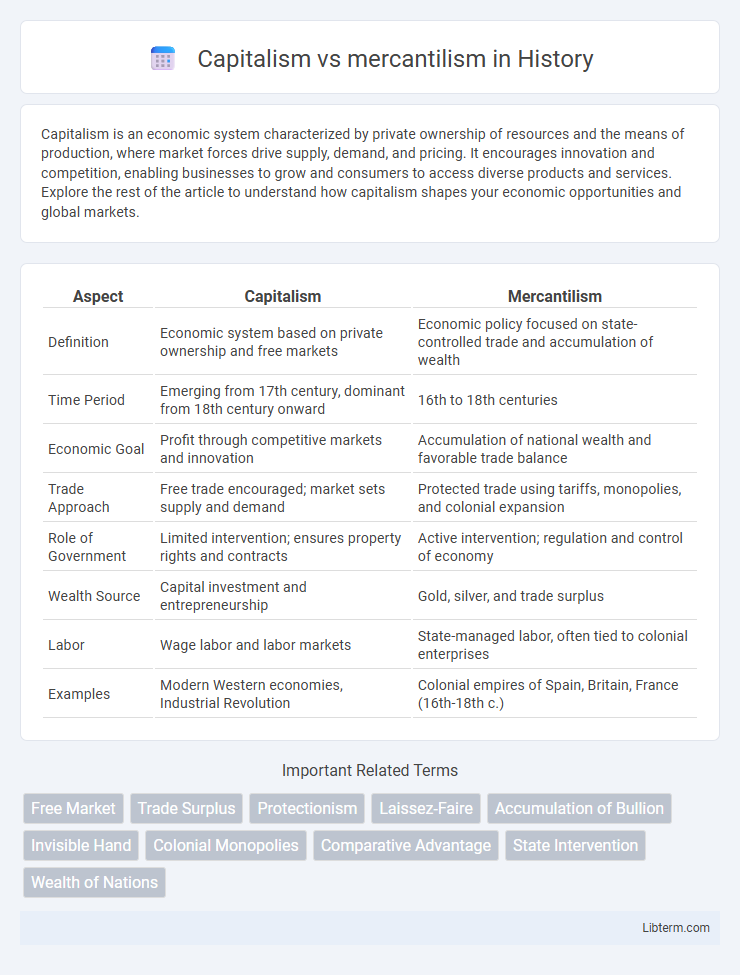Capitalism is an economic system characterized by private ownership of resources and the means of production, where market forces drive supply, demand, and pricing. It encourages innovation and competition, enabling businesses to grow and consumers to access diverse products and services. Explore the rest of the article to understand how capitalism shapes your economic opportunities and global markets.
Table of Comparison
| Aspect | Capitalism | Mercantilism |
|---|---|---|
| Definition | Economic system based on private ownership and free markets | Economic policy focused on state-controlled trade and accumulation of wealth |
| Time Period | Emerging from 17th century, dominant from 18th century onward | 16th to 18th centuries |
| Economic Goal | Profit through competitive markets and innovation | Accumulation of national wealth and favorable trade balance |
| Trade Approach | Free trade encouraged; market sets supply and demand | Protected trade using tariffs, monopolies, and colonial expansion |
| Role of Government | Limited intervention; ensures property rights and contracts | Active intervention; regulation and control of economy |
| Wealth Source | Capital investment and entrepreneurship | Gold, silver, and trade surplus |
| Labor | Wage labor and labor markets | State-managed labor, often tied to colonial enterprises |
| Examples | Modern Western economies, Industrial Revolution | Colonial empires of Spain, Britain, France (16th-18th c.) |
Introduction to Capitalism and Mercantilism
Capitalism is an economic system characterized by private ownership of production, free markets, and competition, where profits drive innovation and wealth accumulation. Mercantilism is an earlier economic theory emphasizing state control, accumulation of precious metals, and trade surpluses to increase national power. While capitalism promotes individual economic freedom and market-driven growth, mercantilism prioritizes government intervention and protectionism to achieve economic objectives.
Historical Origins and Evolution
Capitalism originated during the late Middle Ages with the expansion of trade and the rise of merchant classes, evolving through the Industrial Revolution into a system emphasizing private ownership and market-driven economies. Mercantilism, dominant from the 16th to 18th centuries, was characterized by state control over trade, accumulation of wealth through precious metals, and colonial expansion to secure resources. The transition from mercantilism to capitalism involved diminishing state intervention in favor of free markets and capital accumulation, shaping modern economic systems.
Core Principles and Philosophies
Capitalism centers on private ownership, free markets, and the pursuit of profit through competition and innovation, emphasizing individual economic freedom and minimal government intervention. Mercantilism advocates for state control over trade and economic activity, aiming to accumulate wealth through a favorable balance of trade, government monopolies, and protectionist policies. Core philosophies of capitalism promote wealth creation via supply and demand dynamics, whereas mercantilism relies on government regulation to increase national power and economic self-sufficiency.
Economic Structures and Market Roles
Capitalism is characterized by private ownership of resources, free markets, and competition that drive innovation and consumer choice, whereas mercantilism centers on state control of the economy with an emphasis on accumulating national wealth through trade surpluses and government intervention. In capitalism, markets operate with minimal government interference, allowing supply and demand to determine prices and resource allocation, while mercantilism relies on regulations, tariffs, and colonial expansion to protect domestic industries and maximize exports. The economic structure of capitalism fosters individual entrepreneurship and capital accumulation, contrasting mercantilism's hierarchical system focused on strengthening the state's economic power.
Government Intervention and Regulation
Capitalism promotes minimal government intervention, emphasizing free markets where supply and demand regulate economic activities. Mercantilism advocates for strong government control and regulation to maximize national wealth through trade surpluses and protectionist policies. In capitalism, regulatory frameworks mainly aim to protect property rights and maintain competitive markets, whereas mercantilism relies heavily on tariffs, subsidies, and state monopolies to control the economy.
Trade Policies: Free Trade vs Protectionism
Capitalism favors free trade policies that encourage open markets and competition to drive economic growth and consumer choice. Mercantilism supports protectionism, using tariffs, quotas, and subsidies to maintain a trade surplus and accumulate national wealth. These conflicting trade policies highlight capitalism's emphasis on market efficiency versus mercantilism's focus on state control and economic self-sufficiency.
Wealth Creation and Distribution
Capitalism emphasizes wealth creation through private ownership and market-driven competition, encouraging innovation and efficient resource allocation. Wealth distribution in capitalism tends to be uneven, influenced by market outcomes and individual economic success. In contrast, mercantilism focuses on accumulating national wealth through strict government control of trade, prioritizing export surpluses and state intervention to concentrate resources and power.
Impact on Globalization and Colonization
Capitalism fostered globalization through free trade, investment flows, and market expansion, encouraging competitive economies and the rise of multinational corporations. Mercantilism, centered on state control and accumulation of wealth via colonies, spurred colonization by enforcing strict trade monopolies and resource extraction policies. The transition from mercantilist to capitalist systems significantly accelerated global economic integration and reshaped colonial dynamics.
Criticisms and Controversies
Capitalism faces criticism for fostering income inequality, exploiting labor, and encouraging environmental degradation due to its focus on profit maximization. Mercantilism draws controversy for its protectionist policies, which restrict free trade and often lead to colonial exploitation and monopolistic practices. Both systems have been challenged for prioritizing economic growth over social welfare and sustainability.
Modern Relevance and Comparative Analysis
Capitalism promotes free markets, private property, and competition, driving innovation and economic growth in modern global economies, whereas mercantilism emphasizes state control and accumulation of wealth through trade surpluses and protectionism. Contemporary economic policies prioritize capitalist principles like deregulation and open markets to attract investment, contrasting mercantilist strategies that restrict imports and impose tariffs to safeguard domestic industries. Comparative analysis reveals that capitalism's flexibility and emphasis on consumer choice better support dynamic, interconnected global markets, while mercantilism's rigid control mechanisms often hinder economic efficiency and international cooperation.
Capitalism Infographic

 libterm.com
libterm.com